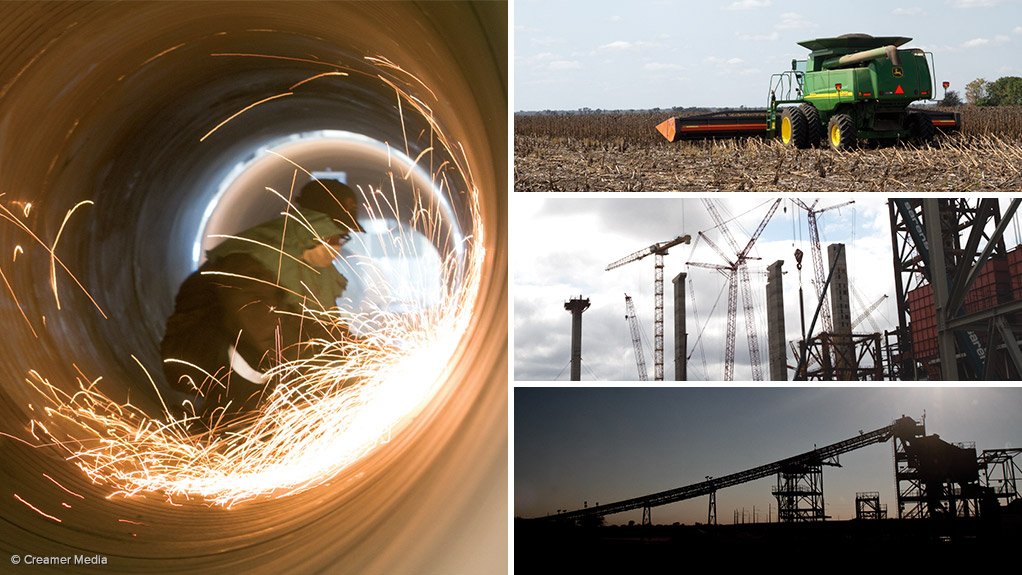South Africa’s gross domestic product (GDP) increased at a yearly rate of 4.6% during the first quarter of 2021, reports Statistics South Africa.
In terms of seasonally adjusted, non-annualised performance, the real GDP growth for the quarter was 1.1%.
The mining and quarrying sectors combined grew by 18.1%, contributing 1.2 percentage points to the overall GDP figure, while the manufacturing sector grew by 1.6% during the quarter, contributing 0.2 percentage points.
Pulling the mining and quarrying figures up was increased production of platinum group metals, iron-ore and gold.
The finance, real estate and business services sectors grew by 7.4%, contributing the most to overall GDP performance, with 1.5 percentage points.
Within the manufacturing sector, motor vehicles, parts and accessories and other transport-related equipment was the largest contributors to increased output.
These were complemented by companies that manufacture wood and wood products, paper, publishers and printers.
Agriculture and electricity fell by 3.2% and 2.6%, respectively, while construction was up 0.8%.
ENCOURAGING GROWTH
The Steel and Engineering Industries Federation of Southern Africa (Seifsa) says the improvement in GDP is encouraging as it indicates increased demand for local goods and services – a key driver for much-needed job creation.
Seifsa chief economist Chifipa Mhango says the rise in GDP is a welcome development, particularly given the current strained economic environment, which is marked by rising unemployment levels, rising input costs and increasing energy costs.
He adds that the signs of economic recovery have been evident, with increasing production levels in key sectors such as the manufacturing and mining sectors, as well as the purchasing managers’ index numbers being in expansionary territory.
Further, Mhango says it was particularly encouraging that the broader manufacturing sector, including the metals and engineering cluster of industries, was among the positive contributors in the secondary sector, rising by 1.6% in the first quarter.
“Five of the ten manufacturing subsectors reported positive growth rates, which bodes well for South Africa given that the sector is seen as key to South Africa’s growth and development [owing] to its multiplier effect into other sectors of the economy,” he says.
However, a decline in gross fixed capital formation, which decreased by 2.6 % in the first quarter, is not supportive of the positive GDP and production figures, says Mhango.
Also, he says, Seifsa is disappointed by the first-quarter decline in net exports of 0.9% amid a 26.5% rise in imports during the same period.
“Given the strained local environment, we urge government to address the challenges faced by the metals and engineering industry that continue to hamper its global competitiveness.
"The speedy implementation of the Steel Master Plan provides an opportunity for government and business to work together to support export growth,” states Mhango.
CAUSE FOR CONCERN
Trade union Solidarity is concerned about the latest GDP figures, stating that GDP growth is not sufficient to compensate for the losses caused by the Covid-19 lockdown measures, to date.
Solidarity research institute economic researcher Theuns du Buisson explains that, although 4.6% growth is better than expected, it should not be forgotten that the GDP contracted by 7% in 2020.
He points out that the more labour-intensive industries, in particular electricity, manufacturing and trade, are suffering the most, especially when taking into account the latest unemployment rate, which is at a record level.
Although Du Buisson says it is gratifying that sectors such as the financial sector are growing, the reality is that most unemployed people are unskilled or semi-skilled and, therefore, do not benefit from growth in those sectors.
“Although the labour-intensive mining sector did grow by 18.1%, this sector is particularly volatile because it is affected by commodity prices on the world market,” he says.
Du Buisson notes that unskilled and semi-skilled labour is precisely where the greatest need for growth is required, but instead is being complicated by regulations, such as black economic empowerment and minimum wage legislation.
Du Buisson adds that capital formation also decreased by 2.7%, which he says shows a clear aversion to investing in South Africa.
However, he enthuses that the problem can be solved with less regulation and the doing away with otherwise “unnecessary and obstructive” regulations.
“By regulating less, everyone can get the opportunity to become part of building up South Africa instead of everyone just sharing in the decline,” says Du Buisson.
EMAIL THIS ARTICLE SAVE THIS ARTICLE ARTICLE ENQUIRY
To subscribe email subscriptions@creamermedia.co.za or click here
To advertise email advertising@creamermedia.co.za or click here











